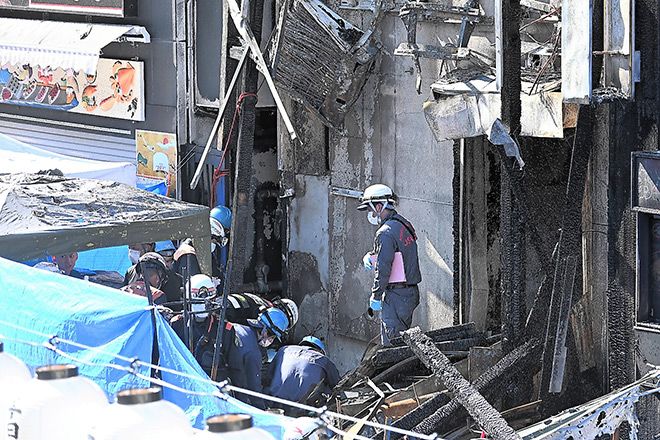OSAKA–Colorful signboards adorning multi-tenant buildings in the downtown Dotonbori district helped spread a raging fire that is believed to have originated in an outdoor air conditioner unit, fire officials said.
The blaze that broke out on the first floor of a six-story building spread along the signs installed on the building’s exterior wall to an adjacent seven-story building, sources in the Osaka Municipal Fire Department said on Aug. 21.
Two Osaka firefighters battling the fire died when a ceiling collapse trapped them on a higher floor.
According to investigative sources, the area around an outdoor air conditioner unit outside of the first floor of the six-story building was severely burned.
Osaka prefectural police are investigating the details, suspecting that the fire originated near the outdoor unit and spread to the neighboring seven-story building.
The fire occurred on Aug. 18 in the Soemoncho district of Chuo Ward in Osaka. The fire damaged 100 square meters, charring the basement to the third floor of the six-story building and reaching the fifth and sixth floors of the seven-story building.
The two buildings, which face the Dotonbori river, are both reinforced concrete structures built in 1968 and are internally connected on the fourth and sixth floors.
A video obtained by The Asahi Shimbun shows the southern sides of the two buildings burning at 9:50 a.m. on Aug. 18.
The footage confirms the flames climbing along the advertisements and their frames on the lower levels of the six-story building and the mid-levels of the seven-story building.
Takao Sakaguchi, a board member of the public interest incorporated foundation “Shimin Bosai Kenkyujo” (disaster prevention for citizens research institution) and a former Tokyo Fire Department officer, analyzed the video and photos of the aftermath.
Sakaguchi pointed out the possibility that the fire from the six-story building may have ascended via the advertising signs and spread to the signage on the middle levels of the seven-story building.
The Osaka Municipal Fire Department also believes the fire on the advertisements of the six-story building spread to the signage on the neighboring building, and then burned through a fifth-floor window of the seven-story building and expanded inside.
It also confirmed that the area around the outdoor unit of an air conditioner had burned intensely in the fire.
Because short circuits inside outdoor units can cause fires, “As a fire prevention measure, it’s an effective safeguard to avoid placing trash or flammable advertising materials around outdoor units,” Sakaguchi said.
According to the Osaka Municipal Fire Department, the firefighting team, including the two firefighters who died, arrived at the scene seven minutes after receiving the emergency call at 9:49 a.m.
The two firefighters, together with another firefighter, entered the first floor of the seven-story building equipped with air tanks.
While battling the blaze on the fifth floor, the ceiling collapsed and the two firefighters reportedly evacuated to the sixth floor, where they were believed to have been trapped.
The ceiling inside the building was reportedly made of wood and other materials, which may have burned and collapsed.
OUTDOOR AIR CONDITIONER FIRES
Fires caused by air conditioner outdoor units have been occurring frequently. The National Institute of Technology and Evaluation (NITE) is calling for caution.
According to NITE, there were 363 accidents involving fire or smoke from indoor or outdoor air conditioning units in the five years through fiscal 2024.
July had the most incidents at 61, followed by August with 47 and January with 40. These accidents resulted in seven deaths and 24 injuries.
Of the 363 cases, 131 involved outdoor units catching fire. Of these, 106 were not caused by the product itself.
These 106 cases involved flammable materials such as cigarettes or trash placed around the outdoor units, which caught fire and spread to the outdoor units.
Other examples involved poor connections in wiring between indoor and outdoor units or compressors in outdoor units exploding due to air intrusion.
“Accidents are more likely to occur during summer and winter because people use air conditioners,” a NITE official said.
(This article was compiled from reports written by Tomoki Miyasaka, Hiroyuki Kojima, Hayato Murai and Shoko Mifune.)


AloJapan.com